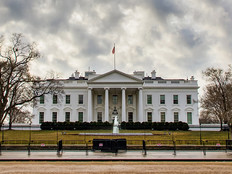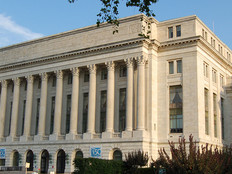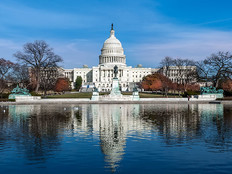Trump Calls for Slight IT Spending Bump in 2019 Budget
No one could accuse the Trump administration of reversing its priorities when it comes to federal IT spending.
President Donald Trump released his budget request for fiscal year 2019 on Feb. 12, and its request for technology spending largely reflects the themes the administration sounded last year. Overall civilian IT spending levels would increase slightly under the budget blueprint, which again emphasizes the importance of modernizing federal IT systems and enhancing the government's cybersecurity posture.
For fiscal year 2019, the White House is requesting $45.77 billion in IT spending for civilian agencies, according to the budget's analytical perspective on IT, up only slightly from the estimated $45.55 billion spent in fiscal 2018. However, as FedScoop reports, "In an analysis of proposed IT spending, the administration notably left out a breakdown of Defense Department IT for the coming year, which equated to $42.5 billion in fiscal 2018."
As The New York Times notes, the budget request "has little to no chance of being enacted as written and amounts to a vision statement by" Trump, who last week signed a two-year bipartisan budget blueprint that differs significantly from the budget's stated priorities.
The Office of Management and Budget notes that the budget request includes funding for 4,113 IT investments at major civilian agencies, 507 of which are categorized as "major IT investments." The 4,113 investments support three main functions: mission delivery; IT infrastructure, security and management; and administrative services and support systems. IT investments can vary widely in size and scope, the budget notes, and the largest 100 investments account for 45 percent of federal IT spending.
Both the White House and Congress have made strides in the push to modernize federal IT. In December, the Modernizing Government Technology (MGT) Act became law. The White House released its plan for IT modernization and has started to stand up "Centers of Excellence" to help agencies carry out the plan's recommendations.
SIGN UP: Get more news from the FedTech newsletter in your inbox every two weeks!
White House, GSA Make Modernization a Priority
The budget proposal includes a $210 million request for the Technology Modernization Fund (TMF), down from the $228 million the administration requested last fiscal year. (The budget documents do not estimate what actually will be spent on the fund in fiscal 2018, FedScoop reports.)
The TMF was established as a key component of the MGT Act provisions in the National Defense Authorization Act for Fiscal Year 2018. The budget says that the fiscal year 2019 funding will "complement any initial seed funding provided in FY 2018, when discretionary appropriations are finalized, and will help grow the revolving fund to a sustained level that will allow the TMF to tackle more complex governmentwide IT modernization efforts."
In addition to the centralized TMF, the law also authorizes agencies to set up working capital funds to fund IT modernization projects. The General Services Administration will administer the TMF, and shortly after the budget was released, the GSA released a statement that the fund "will provide a central mechanism for retiring and replacing antiquated legacy IT systems that are not cost-effective or pose security risks." GSA also announced $20.5 million in new funding for improvements to the IT dashboard and $58.4 million for citizen-centric cybersecurity programs, FCW reports.
Agencies must apply to and compete for TMF funds, the budget notes, and "effective evaluation, selection and monitoring of approved projects by the TMF Board will provide strong incentives for agencies to develop comprehensive, high-quality modernization plans."
"Agencies will provide plans that meet key criteria defined by the TMF Board, which will likely include: having a high probability of success, a strong team and a substantial impact on mission and citizen service delivery," the budget says. "Funds will be distributed in an incremental manner, tied to milestones and objectives."
Cybersecurity Remains a Key Federal IT Concern
As it has in the past, the administration emphasized the importance and challenge of strengthening the cybersecurity of federal networks, systems and data.
The administration's executive order on cybersecurity mandated that agencies conduct risk management assessments, which "demonstrated that the majority of federal agencies could not appropriately manage their cybersecurity risk" and "found enterprisewide gaps in network visibility, IT tool standardization and common operating procedures, all of which negatively affect federal cybersecurity and put our nation at risk."
The budget says the government will move to improve its use of "threat information in its decision-making processes, implement improved baseline security capabilities and enhance accountability for the management of information security risks." Additionally, to protect privacy, prevent fraud and mitigate high-impact data breaches of personally identifiable information, the government "will move to better implement modern digital identity management processes, technologies and remediation techniques."
The administration's budget request for the Homeland Security Department's National Protection and Programs Directorate includes an increase in cybersecurity funding to $712 million, up from an estimated $665 million in fiscal year 2018 and $650 million in fiscal year 2017.
Administration Pushes for More Cloud Tools
Like the Obama administration, the Trump administration is pushing agencies to adopt commercial cloud services. The budget notes that email and collaboration tools are essential to the day-to-day operations at agencies, yet too few have basic collaboration tools such as real-time web-based collaboration tools or videoconferencing.
"In many cases, the tools being used by agencies are more than a decade old and run on legacy systems with growing maintenance costs," the budget states. "This situation is a hidden tax on productivity: it wastes time, creates missed opportunities and slows coordination and creativity."
The majority of agencies that moved to cloud-based collaboration solutions experienced cost savings after just a few years of investment, according to OMB. These cost savings ranged from $500,000 per year for smaller agencies to $10 million per year for larger agencies. For example, the Commerce Department's National Oceanic and Atmospheric Administration was able to migrate to cloud-based email within six months and decommission its legacy servers over the next two years to achieve a total of $3.1 million of cost savings per year.
Migrating more agencies from agency "owned-and-operated email systems to cloud-based email will result in significant cost savings, improved security and greater productivity," the budget states.









